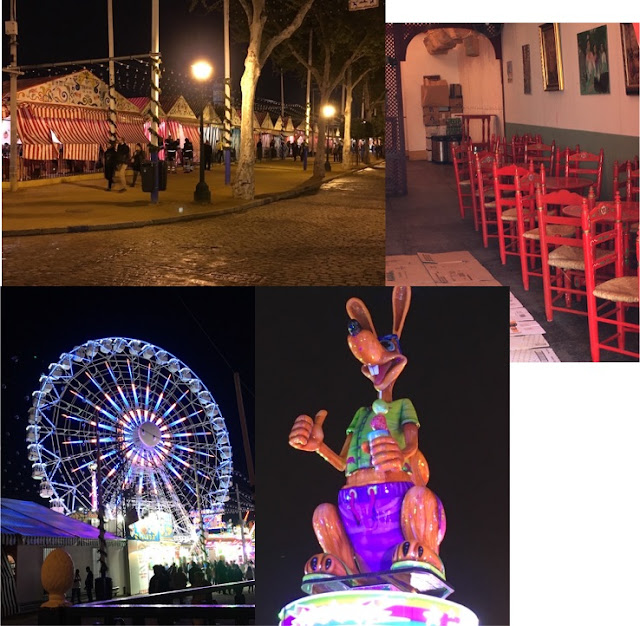Sevilla
After an eventful start, including a taxi strike, Anita being sick, and a missed bus, we arrived in Seville on April 13 (Friday, of course).We stayed at an Airbnb close to the bull ring with Katie, a wonderful woman from England. She has a lovely apartment on the 3rd floor (4th by U.S. count) and has lived in Spain for over 20 years (the same apartment in Sevilla).
For several reasons, Sevilla is possibly the most beautiful large city in all of Spain, primarily because its history, architecture and life itself centers on the Guadalquivir River.
The architecture of the old and new buildings is dramatic. Everywhere you go near and even outside the city center, you see beautiful buildings.
 |
| Clockwise from top right: Cathedral at night, Cathedral during the day, a church near the river, and sculptures in niches on one side of the Cathedral |
In addition to the above, Sevilla is defined by its gardens in the parks, plazas, and along the river; they are serene and refreshing places to walk. Whenever we needed a break, a garden was alway nearby and offered a good place to rest.
 |
| Clockwise from upper right: tortured trees, a small nook in the garden at the Alcazar, the garden at Plaza de Americas, and even a roof garden near the bus terminal. |
 |
| Clockwise from upper right: Island of the birds, the mote around the island of the birds, sculptures, and "Fuente de las Ranas", a frog fountain just for Anita. (All in the park near Plaza de España) |
The Alcazar is definitely a beautiful place to visit and should not be missed on a trip to Sevilla. We enjoyed our day learning about the history and viewing all the different forms of architecture. Another place not to miss is the Plaza de España. I especially enjoyed visiting during the early morning before the crowds arrived.
The Alcazar is beautiful and full of history, but the Plaza de España is grand, truly a place not to be missed in Sevilla. As well as the dramatic architecture and spaces, we especially enjoyed the presentations of historic events and maps showing their locations for each of Spain's states (Spain has over 50 provinces or states and each one is represented). The tile work forming the scenes and the maps is incredible. Beautiful presentations of history.
The 4 presentations of the states that I most enjoyed are shown below.
By accident, we arrived during the week of “Feria”, second only to Semana Santa as celebrations in Seville. The week starts off with the opening of the Feria grounds, where thousands of clubs, families, organizations, and other groups have set up tents where everyone (it seems) in the city meets after 9:00 p.m. for eating fried fish and drinking into the early morning. We walked through the Feria but left at about 11:00 p.m. so missed the lighting of the thousands of hanging lights that occurs at midnight on Saturday. The lights will be turned out ceremoniously at midnight on the following Saturday.
It is truly an amazing event. The tents are set up and taken down every year and most amazing of all is the entrance to the Feria, a huge arch that is designed and constructed uniquely every year.
The Feria is quite the party and includes many daytime activities: bull fights every day for a week (we didn't attend) and a parade of horses and carriages representing various families and organizations from Sevilla. We attended the parade of carriages in the bull ring, the only opportunity to see them in one place (you could see them around town throughout Feria week).
 |
| Andalusia (southern Spain, is famous for its beautiful and well trained horses. The horses circling were from Mexico, this years invited guest. |
On one of my morning walks, I discovered this incredible (for its enormous size and topic) sculpture. Columbus met with Queen Isabella in Sevilla (at the time, the capital of Spain) and Queen Isabella funded his voyage that ended with the discovery and ultimate European settling of America. The sculpture is called "Huevo de Colón" or Egg of Columbus, representing the hatching of the event that led to the colonization of America. The giant sculpture was part of the World Exposition in the 1990's.
 |
| I especially liked the sash with the Niña, Pinta, y Santa Maria sailing to America |
Finally, it would not be right to not mention the famous Spanish hams, hanging in all the good bars and restaurants throughout Spain. I have to say, I have enjoyed the ham and it is very different than ham in the states, much dryer and variable in taste depending on the region. You can get American ham, but why? The restaurant the other day had run out of Iberian ham, tragic. I love the special holders for cutting each ham. Once cured they seem to be able to hang them anywhere, ready for eating.
 |
| Note the hams hanging behind the gentleman cutting slices from a leg. |














No comments:
Post a Comment